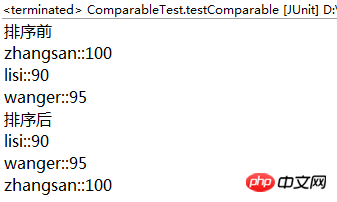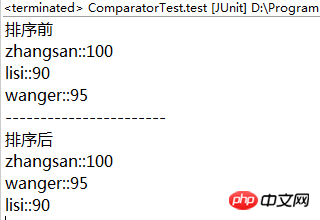Comparison and use of Comparable and Comparator
Overview
1. Background on the use of Comparable and Comparator
Numeric data (byte int short long float double) It is naturally comparable in size and sortable. String implements the Comparable interface and can also compare sizes and sort. However, there are many kinds of custom classes, and there is no common indicator that can be used as a sorting indicator. Therefore, it is necessary to manually establish comparisons in the custom class. Method, for this purpose, java provides two interfaces Comparable and Comparator.
2. Collection sorting
Collections.sort() underlying sorting relies on Arrays.sort(), and Arrays.sort() The bubble method is used for sorting.
二Comparable
Objects that need to be compared in size can implement the Comparable interface and implement the abstract method in it, which is used to set the comparison The way. The following is an example to illustrate:
1. Entity class
package com.javase.collections.comparable;public class Student implements Comparable<Student> {private String name;private int score;public Student() {super();
}public Student(String name, int score) {super();this.name = name;this.score = score;
}public String getName() {return name;
}public void setName(String name) {this.name = name;
}public int getScore() {return score;
}public void setScore(int score) {this.score = score;
}
@Overridepublic int compareTo(Student stu) {return this.score - stu.score;// 操作对象减去参数对象,升序排列,反之降序。 }
}In the compareTo() method, use The attribute score is the sorting indicator, using "this.score-stu.score". The final results are arranged in ascending order, and vice versa.
2. Test class
package com.javase.collections.comparable;import java.util.ArrayList;import java.util.Collections;import java.util.List;import org.junit.Test;public class ComparableTest {
@Testpublic void testComparable() {
List<Student> stus = new ArrayList<Student>();
Student zhangsan = new Student("zhangsan", 100);
Student lisi = new Student("lisi", 90);
Student wanger = new Student("wanger", 95);
stus.add(zhangsan);
stus.add(lisi);
stus.add(wanger);
System.out.println("排序前");for (Student x : stus) {
System.out.println(x.getName() + "::" + x.getScore());
}
System.out.println("排序后");
Collections.sort(stus);for (Student x : stus) {
System.out.println(x.getName() + "::" + x.getScore());
}
}
}Output:

三Comparator
If a class does not implement the Comparable interface when it is created, you want to object to it without modifying the source code To sort, you can implement the Comparator interface and specify the sorting method when calling the sorting method. The following is an example to illustrate:
1. Entity class
package com.javase.collections.comparator;public class Student {private String name;private int score;public Student() {super();
}public Student(String name, int score) {super();this.name = name;this.score = score;
}public String getName() {return name;
}public void setName(String name) {this.name = name;
}public int getScore() {return score;
}public void setScore(int score) {this.score = score;
}
}2. Test class
package com.javase.collections.comparator;import java.util.ArrayList;import java.util.Collections;import java.util.Comparator;import java.util.List;import org.junit.Test;public class ComparatorTest {
@Testpublic void test() {
List<Student> stus = new ArrayList<Student>();
Student zhangsan = new Student("zhangsan", 100);
Student lisi = new Student("lisi", 90);
Student wanger = new Student("wanger", 95);
stus.add(zhangsan);
stus.add(lisi);
stus.add(wanger);
System.out.println("排序前");for (Student x : stus) {
System.out.println(x.getName() + "::" + x.getScore());
}
System.out.println("-----------------------");
Collections.sort(stus, new Comparator<Student>() {
@Overridepublic int compare(Student stu01, Student stu02) {// return stu01.getScore() - stu02.getScore();//升序return stu02.getScore() - stu01.getScore();// 降序 }
});
System.out.println("排序后");for (Student x : stus) {
System.out.println(x.getName() + "::" + x.getScore());
}
}
}In the compare(Student stu01, Student stu02) method, the attribute score is used as the sorting indicator, using "stu01.score-stu02.score", and the final results are arranged in ascending order. Vice versa in descending order.
Output:

##
The above is the detailed content of Comparison and use of Comparable and Comparator. For more information, please follow other related articles on the PHP Chinese website!

Hot AI Tools

Undresser.AI Undress
AI-powered app for creating realistic nude photos

AI Clothes Remover
Online AI tool for removing clothes from photos.

Undress AI Tool
Undress images for free

Clothoff.io
AI clothes remover

Video Face Swap
Swap faces in any video effortlessly with our completely free AI face swap tool!

Hot Article

Hot Tools

Notepad++7.3.1
Easy-to-use and free code editor

SublimeText3 Chinese version
Chinese version, very easy to use

Zend Studio 13.0.1
Powerful PHP integrated development environment

Dreamweaver CS6
Visual web development tools

SublimeText3 Mac version
God-level code editing software (SublimeText3)

Hot Topics
 1393
1393
 52
52
 1205
1205
 24
24
 Is the company's security software causing the application to fail to run? How to troubleshoot and solve it?
Apr 19, 2025 pm 04:51 PM
Is the company's security software causing the application to fail to run? How to troubleshoot and solve it?
Apr 19, 2025 pm 04:51 PM
Troubleshooting and solutions to the company's security software that causes some applications to not function properly. Many companies will deploy security software in order to ensure internal network security. ...
 How to simplify field mapping issues in system docking using MapStruct?
Apr 19, 2025 pm 06:21 PM
How to simplify field mapping issues in system docking using MapStruct?
Apr 19, 2025 pm 06:21 PM
Field mapping processing in system docking often encounters a difficult problem when performing system docking: how to effectively map the interface fields of system A...
 How to elegantly obtain entity class variable names to build database query conditions?
Apr 19, 2025 pm 11:42 PM
How to elegantly obtain entity class variable names to build database query conditions?
Apr 19, 2025 pm 11:42 PM
When using MyBatis-Plus or other ORM frameworks for database operations, it is often necessary to construct query conditions based on the attribute name of the entity class. If you manually every time...
 How does IntelliJ IDEA identify the port number of a Spring Boot project without outputting a log?
Apr 19, 2025 pm 11:45 PM
How does IntelliJ IDEA identify the port number of a Spring Boot project without outputting a log?
Apr 19, 2025 pm 11:45 PM
Start Spring using IntelliJIDEAUltimate version...
 How do I convert names to numbers to implement sorting and maintain consistency in groups?
Apr 19, 2025 pm 11:30 PM
How do I convert names to numbers to implement sorting and maintain consistency in groups?
Apr 19, 2025 pm 11:30 PM
Solutions to convert names to numbers to implement sorting In many application scenarios, users may need to sort in groups, especially in one...
 How to safely convert Java objects to arrays?
Apr 19, 2025 pm 11:33 PM
How to safely convert Java objects to arrays?
Apr 19, 2025 pm 11:33 PM
Conversion of Java Objects and Arrays: In-depth discussion of the risks and correct methods of cast type conversion Many Java beginners will encounter the conversion of an object into an array...
 How to use the Redis cache solution to efficiently realize the requirements of product ranking list?
Apr 19, 2025 pm 11:36 PM
How to use the Redis cache solution to efficiently realize the requirements of product ranking list?
Apr 19, 2025 pm 11:36 PM
How does the Redis caching solution realize the requirements of product ranking list? During the development process, we often need to deal with the requirements of rankings, such as displaying a...
 How to convert names to numbers to implement sorting within groups?
Apr 19, 2025 pm 01:57 PM
How to convert names to numbers to implement sorting within groups?
Apr 19, 2025 pm 01:57 PM
How to convert names to numbers to implement sorting within groups? When sorting users in groups, it is often necessary to convert the user's name into numbers so that it can be different...




